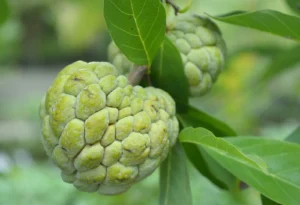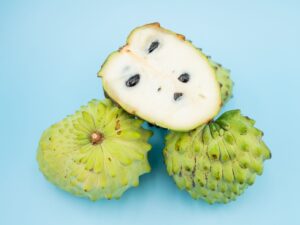Introduction
Custard apple is scientifically known as Annona squamosa. It belongs to the Annonaceae family. The tree of the fruit is very small, native to tropical America and India. It is distributed worldwide and set up in South and Central America, Australia and Africa and is now cultivated in the Philippines, Asia and West Indies.
Annona squamosa has been utilized as a natural drug. Its pulp can be used as a flavouring agent in ice cream, 50% – 80% of custard apple is comestible and can be mashed as juice. It contains perceptible vitamin C in the range of 35 – 42 mg per 100 g, salutary fibre, vitamin B1( thiamine), and potassium contents that are also very high.
Custard Apple: The Nutritive Hustler
The fruit is dense in nutrients. It contains a lot of antioxidants, vitamins, and minerals. As mentioned above, it is a wonderful source of vitamin C, potassium, and fiber, which makes it a great choice for anyone who is looking for a healthy snack.
This fruit contains a unique mixture of compounds, including annonacin, which has been shown to have anti-inflammatory and anticancer properties. Custard apples are also low in calories, and are a single fruit that contains only 80 calories.
Custard Apple: A Taste Sensation

This yummy fruit contains a high volume of protein in it, used in colorful culinary medications. The sweet, delicate pulp is eaten fresh or used in goodies like custards, puddings, and ice creams.
This fruit is also used in savory dishes, such as curries, salads, and salsas. In some societies, the leaves and seeds of the fruit are used in traditional medicines.
This fruit tastes succulent in fruit salad, mixed into yogurt or oatmeal, or blended into smoothies or salad dressings. You can also eat ripened cherimoya like a custard by slicing the fruit in half and scooping out the flesh with a spoon.
Cultural Symbolism and Traditional uses

The custard apple holds significant artistic and spiritual value in numerous societies. In Hinduism, the fruit is considered a symbol of substance and good fortune.
In some African societies, the custard apple is believed to have spiritual powers, used in rituals and observances. In Latin America, the fruit is a chief at family gatherings and fests.
Medicinal Advantages
Research has shown that custard apples retain multitudinous health benefits, including
- It has anti-inflammatory properties.
- It has anticancer properties.
- It supports the immune system.
- It supports digestive health.
- It is high in antioxidants.
- It may boost your mood
- It has alot of Benefits for eye health
- It helps high blood pressure
- It fights inflammation
Growing And Gathering( Tips and ways)
Climate conditions for growing custard apple
Temperature
Custard Apple trees thrives in warm tropical to tropical climates of 20 °C to 30 °C for optimal growth
Downfall
It requires well distributed downfall throughout the time with a normal of 1000 to 1500 mm. Acceptable humidity is pivotal for fruit development.
Sunlight
It requires full sun exposure to thrive. Custard apple needs at least 6 to 8 hours of sun rays per day, that helps in flower inauguration and fruit set.
Propagation ways
▪︎ Seed propagation
▪︎ Cleft grafting
▪︎ scourge and lingo grafting fashion
Fun Facts and Trivia
One fascinating fact about custard apples is that they aren’t actually a single fruit, but a collaborative fruit made up of several individual berries that fuse together.
The custard apple is formed from the emulsion of the carpels of the flower, creating a unique fruit structure that’s both succulent and interesting in terms of its botanical makeup.
This fruit isn’t only delicious but also showcases the complexity and diversity of nature’s creations.
Side effects of Cherimoya( Custard Apple)
Indeed though cherimoya offers emotional health benefits, it contains small quantities of poisonous composites.
》Cherimoya and other fruits in the Annona species contain annonacin, a poison that can affect your brain and nervous system.
》 Experimental studies in tropical areas link high consumption of Annona fruits to an increased threat of a specific type of Parkinson’s complaint that doesn’t respond to common specifics.
》 All corridors of the Custard apple factory may contain annonacin, but it’s most concentrated in the seeds and skin.
》 To enjoy cherimoya and limit your exposure to annonacin, remove and discard the seeds and skin before eating.
Conclusion
The custard apple is indeed a fascinating fruit, with its unique history, nutritive profile, culinary uses, artistic significance, and implicit health benefits making it a name in the world of fruits.
As we continue to explore the vast array of fruits available, it’s essential to fete the significance of custard apples in our culinary and artistic heritage.
Whether you’re a savourer, a health sucker, or simply a curious existent, the custard apple is a fruit worth discovering. So, go ahead and indulge in this tropical treasure, and witness the seductiveness of the custard apple for yourself.

